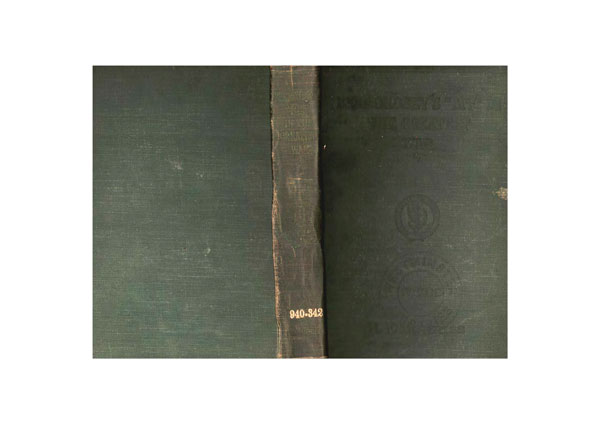Description
At least one of these publishers was a “Courtesy Publisher”– i.e. the author paid the publisher, who might undertake to sell some copies but the disposal of the bulk was th responsibility of the author, who might try to sell them, or even give them away. As a result this book is not an easy read, the priority apparently being to cram as many names in as possible to increase sales. Furthermore, there is no index, or proper chronology, and material which should be grouped together is spread over two or more sections.
Apart from contributing a large number of young men to the armed forces and to welfare efforts at home on their behalf (beyond the scope of this review) Bermondsey`s main contributions to the War Effort was as “London’s Larder”, the traditional local leather trade, much in demand for horse harness and uniform accoutrements, and packaged foodstuffs for the troops. There was also a significant local chemical industry, which at short notice came up with an antidote to the horrific poison gas attacks on the Western Front, and at the outbreak of the War, Rotherhithe was said to hold virtually the entire British stock of saltpetre and sulphur, at Brandrams on the Lower Road. I found this difficult to believe, but then I remembered a passage in Churchill’s “The World Crisis”. He described his shock on becoming Home Secretary, to discover that the entire British reserve of cordite – the propellant used in big naval guns – was stored in a wooden shed in Epping Forest, secured by an ordinary padlock, and a single unarmed Metropolitan policeman.
So far as food supplies are concerned, the author has harsh things to say about the Americans, not least because they were sending over cargoes of rotting bacon. U-Boat activity the North Atlantic, and the St. George’s Channel, caused the diversion of some of the Cunard North American trade from Liverpool to the Surrey Docks. Alaunia,,Andania, ,Ausonia, Ascania, Carpathia, Feltria, Vandalia,Vinovia and Volodia, were all recalled as arriving with “great cargoes of foodstuffs and shells”.
I am grateful to Stephen Humphrey for the following biographical note on the author, He was born at Ilford in 1860 but appears to have spent at least some of his school days at Wolverhampton. He had an aunt in Rotherhithe and came to be associated there with Manor Chapel in Galleywall Road, which then belonged to the United Methodist Free Churches. He was still involved with that church in 1935. Despite this connection, he ran St. Winifred’s Hall from 1892, and then moved his congregation from there to the Southwark Park Congregational Chapel in 1906, where he became the lay pastor.
In business, he was a metal trader, as a result of early employment by a friend of his father. He had premises on Lower Road Rotherhithe, and was also based at Lime Street in the City and then at 20 Clifton Street, Finsbury. After going to considerable expense in refurbishment, unspecified war time conditions the Lower Road premises had to be given up, and were taken up by Cunard.
He was a prolific author. Bermondsey’s Bit, dates from 1923, but Two Brave Brothers, about Charles S. Rolls and his brother, the 2nd Lord Llangattock, dated from. In 1914 he had published an autobiography, of which I knew nothing. This refers to many connections, including local cricket. Less usefully, he published The Allies Alphabet, a strange poetical ramble on the First Word War, plus a full book of poems, apparently in 1923, which are not likely to help the world,
His career from his two years as Mayor of Bermondsey, seemed to take off very quickly from about 1906. He may have seen it as a useful parallel to his local religious work. The latest reference to him I can find dates from 1937.
I have mentioned the confused chronology – in fact he is very sparing with dates, presumably because his local readership knew them. He is quite good on air raids and air raid precautions precautions, (but no dates) including searchlight batteries and “Barking Charlie” a one ton quick firing 3inch gun, taken up in sections and mounted on the upper walkways of Tower Bridge. My word! They must have been brave men up there! In one raid alone, they fired 486 shots, an average of 22 rounds per minute. As an aside, some years ago, I did some research into airship raids on London, including the one which caused damage in Keeton’s Road. The aircraft in this case was not a Zeppelin, but an army operated Schutte-Lanz airship, similar to the Zeppelin, but with a wooden framework instead of aluminium. The captain was an army officer, and old Boy of Dulwich School whose father had been Siemens manager at Charlton. Army airship commanders were notoriously bad navigators (although some of the Kaiser-Marine 0fficers were not much better) Perhaps he had been given this mission because of supposed local knowledge, but he cruised around dropping bombs almost at random, causing little serious damage.
The author fails to mention the “Dug Out” under the South Eastern & Chatham side of London Bridge station, where telephone and telegraph reports of enemy aircraft activity, from stations and signal boxes all over the country were received, co-ordinated and passed to the relevant military authorities within minutes. Knowledge if this was in the public domain by 1922.
I have hinted that this is quite an irritating book, but it does contain many “plums” which will repay patient delving.
PREVIEW BELOW – MAY TAKE A WHILE TO LOAD.

Reviews
There are no reviews yet.